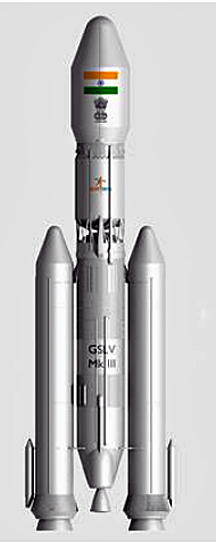
Illustration of the GSLV Mk III rocket which will be launched on June 5,.2017.
Image is courtesy of ISRO)
The Indian Space Research Organisation (ISRO) will be launching GSLV Mk III with the LVM 3, a heavy launch capability launcher, on June 5.
Called the Fat Boy Satellite, the GSLV Mk III will enable India to send manned missions to space. Additionally, the satellite will also aid in making India self-reliant for launching satellites as the GSLV would be capable of placing 4 tonne class Geosynchronous satellites into orbit. The satellite will use an indigenous Cryogenic rocket stage. The first time the LVM 3 made a test flight was on December 18, 2014, as the LVM3-X/CARE mission, lifted off from Sriharikota.
The Fat Boy satellite is 43.43 metres in height and 4 meters in diameter. It has a lift off mass of 640 tons. As opposed to the GSLV Mk II, which can only place two ton class of satellites in space, the GSLV Mk III will be able to place four ton class satellites into GSO. The indigenous cryogenic stage LVM 3 also makes it capable of placing heavy payloads into LEO of 600 km altitude. The C25, powered by CE-20, is India’s largest cryogenic engine which has been designed and developed by the Liquid Propulsion Systems Centre of ISRO. A cryogenic engine provides more thrust for every kilogram of cryogenic propellant — liquid hydrogen or liquid oxygen — that it burns. It can store 27 tons of such propellant and has a thrust of 186 kiloNewton.
The LVM 3 also has two Solid Rocket Boosters, S200, that provide a huge thrust that is required for it to lift off. They require a burn time of 130 seconds,and have a thrust of 9,316 kiloNewton.
Even though the satellite enables a manned mission, the chairman of the ISRO chairman stated that won’t be possible until government approval is received. prior government approval.
Tapan Misra of Ahmedabad-based Space Application Centre stated that GSLV Mk III will have one of the world’s heaviest solid motor engines and will have two strap-ons — this rocket is much more maneuverable than other rockets launched earlier and this feature will help us change its position in space.
Story sourced from The Indian Express.

